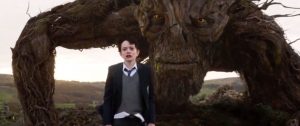Ángeles Martínez-García and Antonio Gomez-Aguilar, University of Seville. Visiting Scholars at the University of Southampton. July, 2018.
The Spanish director J. A. Bayona´s cinema belongs to that group of productions that has taken the Spanish cinema outside its borders in the new millennium. His three films have beaten box office records and are the reason why their director is known as “universal”. Both The Orphanage (2007), The Impossible (2012) and A Monster Calls (2016) become part of an “improvised trilogy”, baptized by Bayona himself, as they all have a deep symbolic triangle in common: mother – son – death. In all of them the main characters have to face the truth of suffering and this will lead them to a process of personal transformation that will connect with the most intimate spectator´s self. The three main characters of Bayona’s films have something in common: they all start a hard journey that involves self-knowledge and self-improvement. That is the reason why these three films can be related to the myth of the labyrinth, as this is a metaphor of a “path to knowledge”: All of them have lost their most valuable possessions, that is to say, their closest relatives – a mother, a son, an entire family – and through the search process they all go through a “path to knowledge” as they learn a lot from their suffering. Laura (The Orphanage, 2007) has lost her child; Lucas (The Impossible, 2012) has lost his entire family; Conor (A Monster Calls, 2016) is about to lose his mother.

| Figure 1. A frame of A Monster Calls. Conor is one of the main characters in Bayona’s films that has to face a hard future. |
We have found several identical structures in the myth of the labyrinth and Bayona’s films, as they both refer to a profound change in certain characters after a hard journey:
- Theseus: An active subject; he starts the self-knowledge journey.
- Labyrinth: A spiritual and/or physical journey that someone goes through, with an initial loss and full of problems.
- Minotaur: It features in the centre of the labyrinth and in the most important moment, when Theseus faces himself and his problems. It means a turning point in the journey and since that moment Theseus / the traveller will suffer a profound change.
- Ariadne: A key character. Without her, Theseus could not have found the exit of the labyrinth despite having beaten the Minotaur.
On the basis of these similarities, we have prepared this figure:
| REPRESENTATIONAL STRUCTURES | The Orphanage (2007) | The Impossible (2012) | A monster calls (2016) |
| Theseus | Laura (the mother) | Lucas (the son) | Conor (the son) |
| Labyrinth | Searching for the lost son (death is not expected) | Searching for the lost family (death is possible) | Accept sickness and loss (certain death) |
| Minotaur | Facing the truth: her son is dead | Facing the truth: the whole family may be dead | Facing the truth: the mother will certainly be dead |
| Ariadne | Her son | Mary (the mother) | The tree |
| Table 1. Content analysis of Bayona’s films. | |||
There is always a main character (Theseus) in Bayona’s films that has to face a terrible fact (Minotaur) after going through a hard physical and/or mental journey (labyrinth). Different Ariadnes come along with them along this profound personal change. In these three films we can found ordinary characters that turn into heroes as they have to face “giants”, that is to say, big challenges in their lives.
This similarities are remarkable because spectators don’t usually watch films with the idea in mind that there is a much more profound meaning in their stories than is usually discovered. We all should take into account that there might be a lot more “labyrinths” in films, which are similar to those ones that we go through in our own lives.
If you want further information about this case study, you can find it in the paper: “El minotauro escondido en la trilogía de J. A. Bayona.” In the journal Arte, Individuo y Sociedad 29(3) (2017), 555-569. ISSN: 1131-5598. http://dx.doi.org/10.5209/ARIS.56031, pp. 555-569.
Ángeles Martínez-García (angelesmartinez@us.es) is a professor at the University of Seville, Faculty of Communication, with more than ten years of experience in university education. Her goal is to meet standards through students´ engagement. She teaches on Film Studies and Film Image and she is developing current research on myths and cinema, as well as on the analysis of film image.
Antonio Gomez-Aguilar (agomez16@us.es) is a professor with more than ten years of experience in university education and vocational training. He has been working on analysing the Andalusian Audiovisual Sector. He teaches on Studies, Technology and Communication. He is developing current research on a new television concept, as well as on technology of communication.
